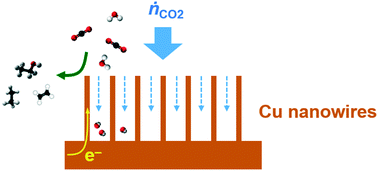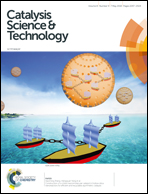Mass transfer effects in CO2 reduction on Cu nanowire electrocatalysts†
Abstract
Significant interest has risen in the development of catalytic nanomaterials for the electroreduction of CO2. While extensive studies have been reported on tuning of surface structures to improve the chemical kinetics, less attention has been paid to the mass transfer effects in the CO2 reduction reaction on nanoscale electrocatalysts. We report here a systematic investigation of CO2 electroreduction on highly dense Cu nanowires, with the focus placed on practically relevant high-flux conditions. Mass transfer effects are found to play an important role in this case, giving rise to diffusion-limited CO2 reduction activity and selectivity. By correlating the observed transport phenomena to the CO2 conversion rate calculated from the experimental data and the surface concentration of CO2 on the nanowires derived from transport modeling, an upper limit is revealed for the CO2 conversion rate on the nanostructured electrodes, which also causes the drop in Faradaic efficiency of CO2 reduction at large current densities. Our work emphasizes the necessity of considering mass transfer effects in the design of advanced electrocatalysts for CO2 reduction as well as for understanding their structure–performance relationships.



 Please wait while we load your content...
Please wait while we load your content...
